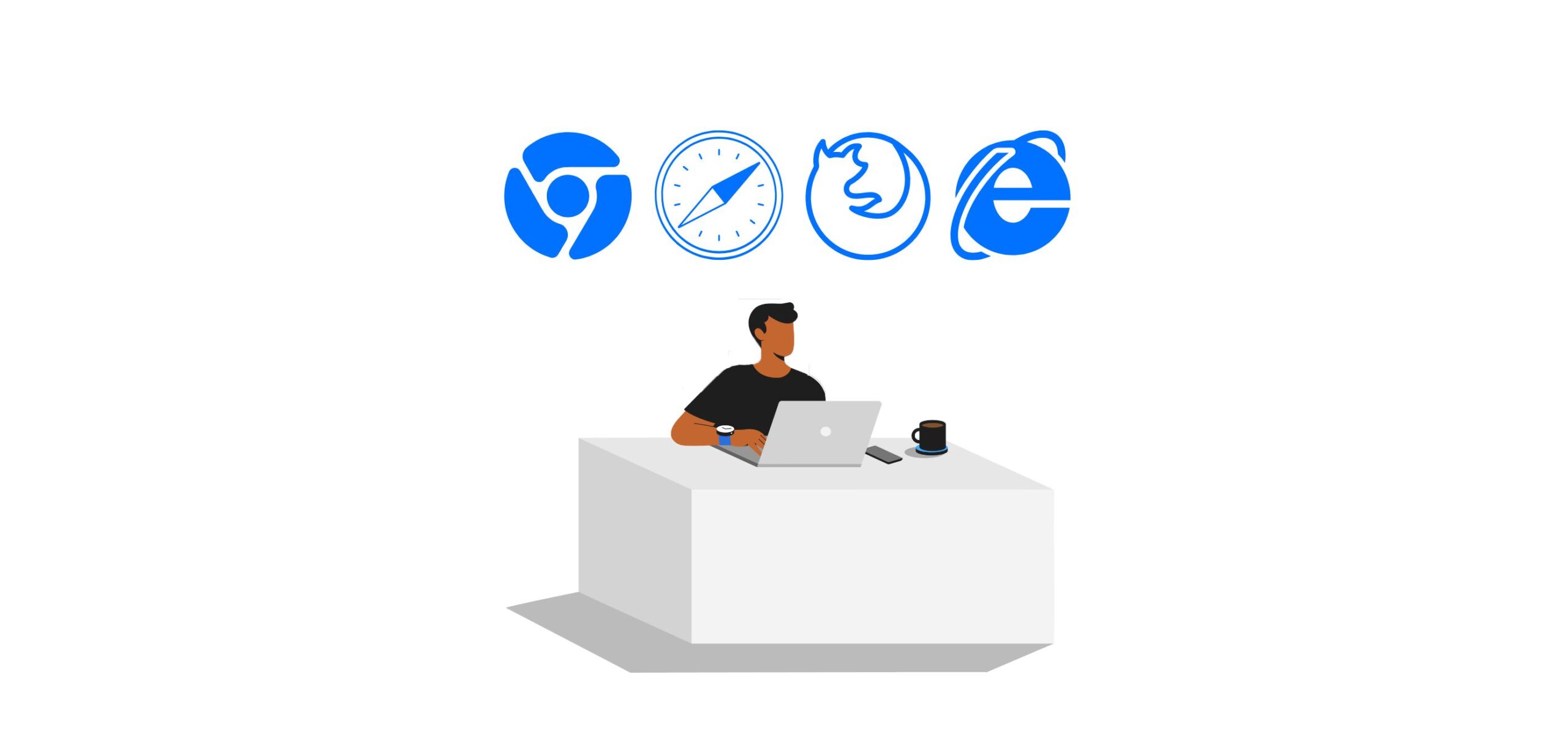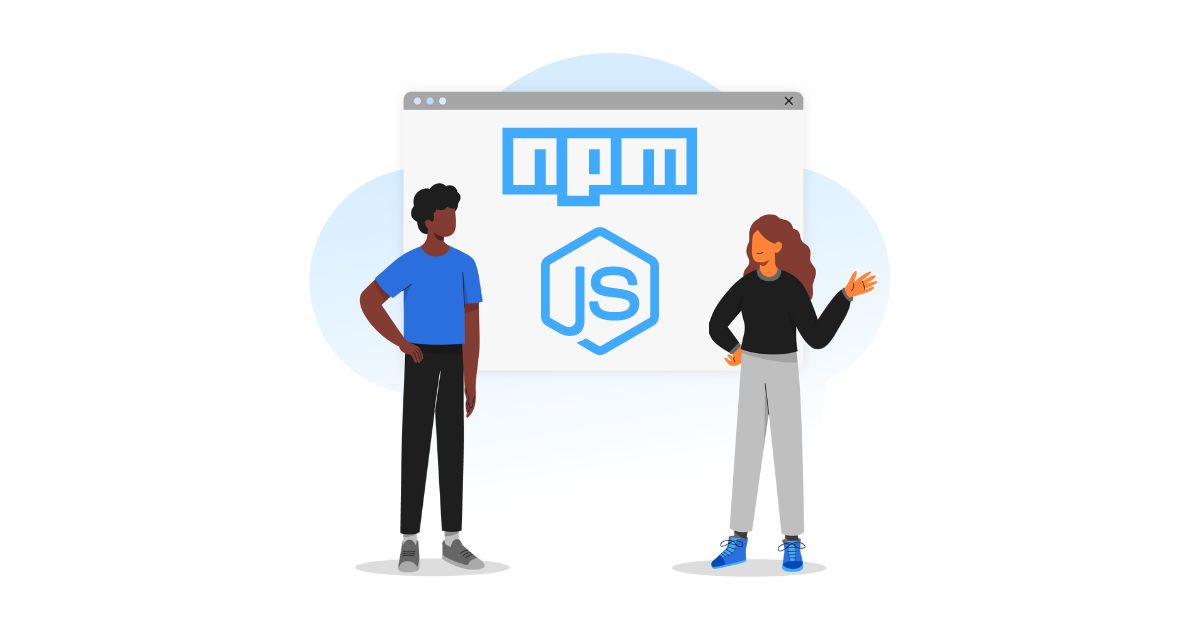What Is Cross-Browser Compatibility Testing? What Are Its Best Practices?
In today’s digital world, a website is a customer’s first impression of a company. As a result, it has become important for websites to be visually appealing and user-friendly. However, with the variety of web browsers available to consumers, ensuring that a website looks and works the same across all platforms can be challenging. Cross-browser compatibility testing is the process of testing a website across multiple web browsers to ensure that it is compatible with all of them.
This blog covers all the basics of cross-browser testing along with the practices for cross-browser compatibility testing.
|
Table of Contents
|
What is cross-browser compatibility testing?
Cross-browser compatibility testing is the process of testing a website or web application to ensure that it is correct and consistent across all browsers and browser versions.
A more technical definition from TechTarget states that “cross-browser testing, also known browser testing, is a quality assurance (QA) process that checks whether a web-based application, site or page functions as intended for end users across multiple browsers and devices.”
As a developer, brand, or content creator, you do not want your website or application to look different or unorganized on separate browsers. Since different browsers display web content uniquely, cross-browser compatibility testing helps ensure consistency in presentation regardless of which browser users are on.
The testing process involves opening your website or application in various browsers like Chrome, Firefox, Safari, and more, and checking for functional or visual differences. Using various testing tools helps you check for any layout issues, such as overlapping or misaligned elements. You can as well verify that all features and functionality work as intended.
What are browser compatibility issues?
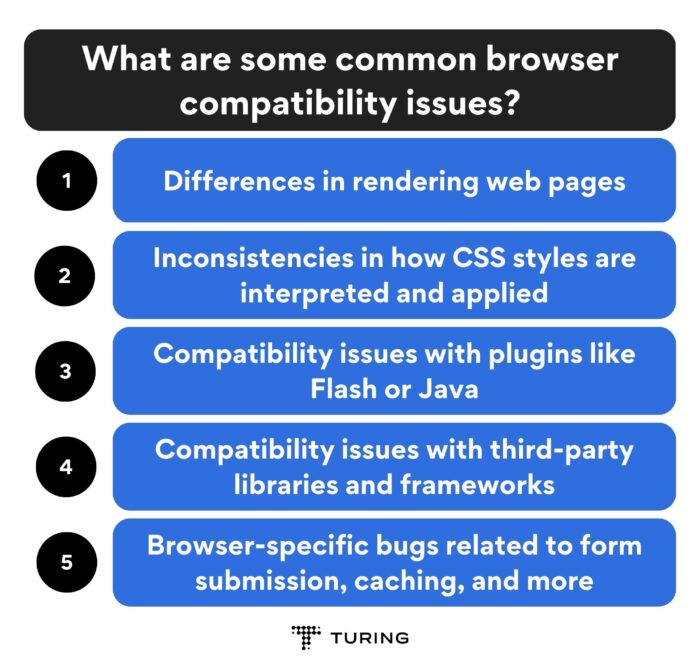
What are some common browser compatibility issues
Some common issues that can arise during cross-browser testing include:
- Differences in rendering web pages
- Inconsistencies in how CSS styles are interpreted and applied
- Compatibility issues with plugins like Flash or Java
- Compatibility issues with third-party libraries and frameworks
- Browser-specific bugs related to form submission, caching, and more
Also, read Cache Control Headers and Their Use Cases You Must Know!
What is the difference between cross-browser and compatibility testing?
Cross-browser testing and compatibility testing in software testing are related concepts in the field of software development, but they are not exactly the same.
Cross-browser testing is the process of testing a website or web application across different web browsers to ensure that it works correctly and consistently across all of them. The aim is to identify and fix any issues or inconsistencies arising from browser-specific differences. Cross-browser testing ensures the website or web application looks and functions as intended across different browsers.
Compatibility testing, on the other hand, is a broader concept encompassing testing a software application across different environments, including operating systems, devices, browsers, and other relevant configurations. Compatibility testing in software engineering ensures that the software works well and is compatible with the intended target environment.
Why is cross-browser compatibility testing important for developers?
As a developer who works with or plans on working with different clients, it is imperative to have a great-looking website on most browsers to leave a strong impression.
Browser compatibility testing is often overlooked during the website development process. Developers and designers usually focus on using one browser, especially Chrome, when building a site and may check it on a few other browsers before considering the project complete. This is acceptable for a simple site but not for complex, large-scale websites.
By conducting cross-browser compatibility testing, developers can identify and fix compatibility issues before deploying the website or application. This can help ensure a consistent user experience across different browsers and devices, improving user satisfaction, increasing traffic, and driving conversions. Of course, this is what every developer should aim for.
Types of cross-browser compatibility testing
There are two main types of compatibility tests: backward and forward compatibility tests.
Backward compatibility testing
Backward compatibility (downward compatibility) testing verifies whether a new version of a software application is compatible with the previous version(s). It ensures that the new software version can work with the data, configurations, and other components used in the earlier versions without any issues or errors.
Forward compatibility testing
Forward compatibility testing verifies whether a software application or system can work seamlessly with future software or hardware component versions without compatibility issues or errors. It is also known as “upward compatibility testing” or “future compatibility testing.
Other more specific types of compatibility testing include:
- Browser (Cross-browser) compatibility testing: This ensures your site or app is compatible across multiple browsers.
- Mobile compatibility testing: This testing ensures that a mobile application is compatible and functions correctly across mobile devices like iOS and Android OS.
- Device compatibility testing: ensures that an application is compatible with devices such as USB port devices, Bluetooth, printers, and more.
- Network compatibility testing: ensures your application compatibility and performance with different networks like Wi-Fi, 3G and 4G networks, and more.
- Operating system (OS) testing: ensures your application is compatible with various OSs like Windows, Linux (Debian, Ubuntu, etc.), and Mac.
Also, read: Core Web Vitals: What Are They and How to Improve Them?
Who performs cross-browser compatibility testing?
Cross-browser compatibility testing can be performed by various professionals, including web developers, software testers, quality assurance engineers, and web designers. Today, the market has several browsers, versions, and systems. And so, it can be daunting for the tester to decide which one to use. Fortunately, this decision is heavily influenced by the client, business analysis, and marketing teams. Furthermore, businesses also acquire the website’s or app’s usage and traffic data to identify the most popular devices, environments, and browsers.
As mentioned above, the QA and design teams may both be involved in the process of cross-browser testing. However, regardless of which team conducts the evaluation, the design and development teams thoroughly assess the results and make required adjustments accordingly.
Seven best practices for cross-browser compatibility testing
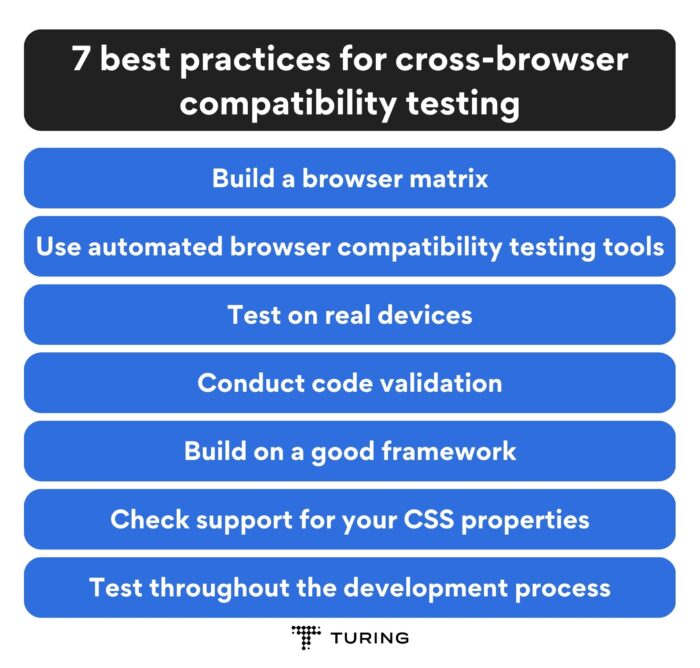
7 best practices for cross-browser compatibility testing
This section will cover some best practices for successful cross-browser compatibility testing.
Build a browser matrix
A browser matrix involves listing the browsers and versions you are designing the website. Making your application compatible with every browser and browser version is nearly impossible. This is because different browsers accept and reject various CSS properties. This process is common. Therefore, you must decide which browsers are most important for your site or application and target them and their various versions.
For you to effectively build a browser matrix, you should first think about your target audience. For instance, if you have an audience of marketers who use Chrome, develop accordingly.
Since the general audience constantly updates their browsers, your browser matrix should also be updated.
A browser matrix helps you plan what components you can use on your website.
Use automated browser compatibility testing tools
One of the best ways to run a successful compatibility test is by using automated browser compatibilities tools like BrowserStack, Sauce Labs, LambdaTest, and more. An automated testing tool can save time and effort during cross-browser compatibility testing. These tools can test websites across multiple browsers and provide detailed reports on any compatibility issues found.
Test on real devices
Testing a website on real devices ensures it functions correctly across all platforms. Emulators and simulators can be useful tools, but they do not always accurately replicate the experience of using a real device. Testing on real devices can also help to identify any issues with touch functionality or screen resolution.
Conduct code validation
Code validation deals with checking your code to see if it is in accordance with W3C standards. As a web developer, it is important you do this. Not following these standards can lead to your site or applications winding down. A well-validated and formatted website will make your application compatible, along with other benefits like improved SEO, easy maintenance, and more.
Build on a good framework
As a web developer, building a website with a good framework is a great start toward cross-browser compatibility. Frameworks are optimized for cross-browser issues from the go and automatically create responsive elements, so developers don’t need to hardcode.
Bootstrap is a good example of a framework. It comes with in-built functions that are responsive. All you need is to inherit the class and element, and your web application will be rescaled automatically on smaller devices.
Check support for your CSS properties
As stated earlier, different browsers support various CSS properties. What one browser supports, another browser won’t. For instance, the Chrome Browser supports the backdrop-filter property but not Firefox.
Fortunately, tools like ‘Can I Use’ lets you check CSS properties compatible with each browser. You will no longer waste much time designing a poorly-supported web application.
Also, read: 6 Contemporary Designs Using CSS with Code Samples for 2023
Test throughout the development process
Cross-browser compatibility testing should not be left until the end of the development process. Testing should be conducted throughout the development process to identify and address any compatibility issues as they arise. This saves time and effort in the long run by preventing the need for extensive testing and debugging at the end of the process.
Also, read: 10 Popular Software Testing Trends in 2023
Best tools for cross-browser testing
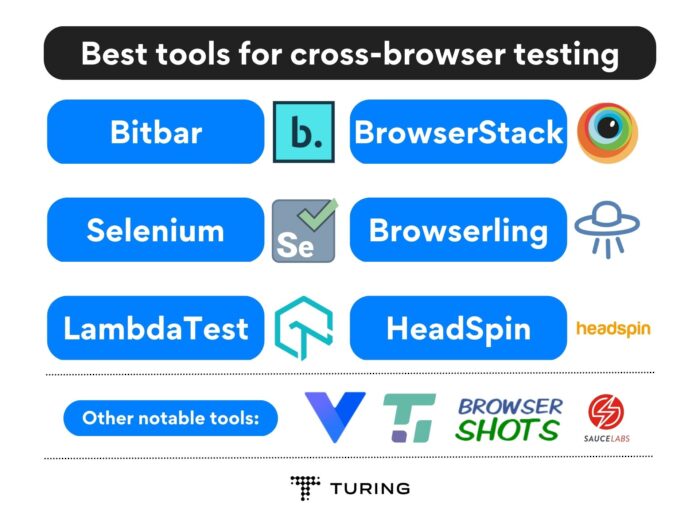
Best tools for cross-browser testing
Let’s look at some of the top recommended tools that help streamline the process of cross-browser testing.
BitBar
Bitbar offers a cloud-based real device lab that enables you to deliver optimal web and mobile experiences to your customers across various browsers and devices. With BitBar, you can easily conduct manual and exploratory tests on real browsers, desktops, and mobile devices, ensuring your customers have the best experience on the latest and most popular platforms.
Selenium
Selenium is widely recognized for its ability to automate the testing of web-based applications. With the simple step of changing the browser for test case execution, Selenium enables easy and efficient running of the same test cases across multiple browsers, making it a convenient option for automated testing.
LambdaTest
LambdaTest LambdaTest is a cloud-based solution enabling users to conduct automated and manual compatibility testing for their websites or web applications across over 2000 browsers and operating systems.
BrowserStack
BrowserStack is a web and mobile testing platform that operates on the cloud, allowing users to test applications on various browsers, operating systems, and real mobile devices on demand.
Browserling
Browserling offers a live and interactive testing service that allows web developers and designers to test their websites across various browsers and operating systems easily. With quick access to popular browsers and operating systems, Browserling simplifies the testing process for web developers and designers.
HeadSpin
HeadSpin enables users to conduct cross-browser tests on real devices in the cloud, allowing them to test the responsiveness of their mobile applications or websites remotely. Additionally, users can perform performance tests, such as load testing, on authentic environments, ensuring highly accurate results.
Other notable tools include:
- Virtuoso
- TestGrid
- Browsershots
- SauceLabs
Conclusion
Cross-browser compatibility testing is essential to ensure a website functions correctly and looks visually appealing across all platforms.
By understanding the differences between web browsers, defining the scope of the test, using automated testing tools, testing on real devices, testing throughout the development process, focusing on user experience, and testing with real users, website developers can ensure that their website is compatible with all web browsers and provides a positive user experience.
FAQs
Which are the best techniques for cross-browser compatibility?
Some of the best techniques for cross-browser compatibility include:
- HTML or XHTML validation
- Page validation
- Ajax or JQuery functionality
- Font size validation and more
How do I ensure cross-browser compatibility?
You can ensure cross-browser compatibility using the following ways:
- Validate your HTML and CSS code using Jigsaw CSS validator and CSS Lint.
- Maintain Layout Compatibility
- Make use of CSS Resets
- Check DOCTYPE TAG
What is an example of browser compatibility?
A good example of browser compatibility is a mobile phone on Android displaying websites on Chrome browser differently from an iPhone on Safari browser.
What is the key reason for checking cross-browser compatibility?
Cross-browser testing helps you to identify browser-specific compatibility errors so you can debug them right away. Most importantly, it makes sure that you’re not excluding any part of your target audience just because your website does not work well on their browser.
Join a network of the world's best developers and get long-term remote software jobs with better compensation and career growth.
